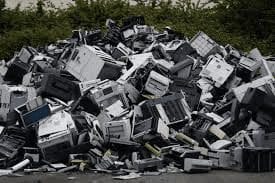E-Waste ‘Tsunami’ Presents Both Risks And Potential Rewards – By Jan van der Kaaij (IB Times) / Feb 8 2019
E-waste is the fastest-growing waste stream in the world, deservingly winning it the title of a “tsunami” as volunteered by the United Nations Environment Programme. According to the World Economic Forum, this waste stream is thought to have reached the mark of 48.5 million tons in 2018. To put this amount into perspective, 50 million tons of e-waste roughly represents the equivalent of 125,000 jumbo jets, which is more than all the commercial aircraft that have ever been created.
While there are large differences in recycling ratios in each country, globally society only properly recycles about 20 percent of its e-waste. If this scenario continues unchanged, humanity will face a swelling wave of 120 million tons of e-waste per year by 2050, and it will consist of many high-value and scarce materials, such as gold, platinum, cobalt, rare earths, and high quantities of aluminum and tin.
Of course, precious metals are called precious for a reason; they represent value. It is estimated that at current the global e-waste stream is worth $62 billion annually, highlighting the fact that the tsunami presents an opportunity as well as a frightening challenge.
 *This photo shows a pile of discarded electrical and electronic components at Morphosis plant in Le Havre, northwestern France, May 3, 2017. Photo: CHARLY TRIBALLEAU/AFP/Getty Images
*This photo shows a pile of discarded electrical and electronic components at Morphosis plant in Le Havre, northwestern France, May 3, 2017. Photo: CHARLY TRIBALLEAU/AFP/Getty Images
One of the companies that has valiantly leaped at this opportunity is Brussels-based Umicore. This former mining company left its dark past behind to become a global leader in the circular economy movement, touted around the globe for its battery recycling technology. This spectacular turnaround took more than 10 years and turned Umicore into a stock market darling, ultimately earning the company a place as the European partner in Tesla’s Closed Loop Battery Recycling Program.
With the fast-increasing global production of lithium batteries, the price of one of its main raw materials, cobalt, continues to flare up, tripling in 2016 and 2017. This inspired the Democratic Republic of Congo, the world’s leading cobalt producer, to raise its taxes and royalties on metals, including copper and cobalt in early 2018. And to protect its electric-vehicle industry, China began buying controlling interests in the largest mines in the Congo. Companies such as Apple, Tesla and others were experiencing shortages in the supply of their sustainable cobalt. Unsurprisingly, all these market developments favored Umicore, as the window of opportunity for recycled cobalt grew bigger and bigger. In February 2018, Umicore reported a record performance for the 2017 financial year. Growth was in large part driven by its Energy & Surface Technologies business group, which increased its revenues by 46 percent, mostly due to volume growth in rechargeable battery materials.
 *A pile of dead batteries is pictured at Ash Recyclers, a government approved e-waste management firm in Bangalore, India, June 5, 2013. Photo: Manjunath Kiran/AFP/Getty Images
*A pile of dead batteries is pictured at Ash Recyclers, a government approved e-waste management firm in Bangalore, India, June 5, 2013. Photo: Manjunath Kiran/AFP/Getty Images
In its report, the World Economic Forum stresses that even if e-waste can present an attractive opportunity for business, the current linear mine, make, use and dispose approach is unsustainable. To address our growing e-waste challenge, the World Economic Forum offers five prohibitors that need eliminating:
- Opaque value chains with a lack of transparency on material origin, content, condition and destination
- Linear product design
- Linear lock‐in due to lack of asset management infrastructure required to ascertain the condition and value of used products.
- Inefficient collection and reverse logistics
- Insufficient sorting and pre‐processing infrastructure
Due to the complexity of the product composition, many additional data insights on impact are required to make the correct trade-offs. One of the early movers on impact measurement is showing interesting results in that area. Dutch NGO Wecycle is the organization that manages the collection and recycling of e-waste in the Netherlands on behalf of 1,750 producers and importers. In 2017, Wecycle collected 107,000 tons of electronic waste, offsetting 345,000 tons of CO2 equivalents and the organization has made serious efforts to better understand their value chain impact. Over the past decade, in collaboration with LCA specialist PRé Sustainability, Wecycle has been quantifying the environmental benefits of their recycling efforts in detail, providing them with improved management information. To account for the burdens of recycling, all recycling activities, such as sorting and shredding, were modelled in detail and recovered materials such as aluminum were compared with their virgin material cousins, to estimate the benefits of material recycling. This not only helped to engage consumers and other stakeholders, it provided process information that allowed for significant efficiency improvements.
According to the data, the “tsunami” of e-waste is a risk and reward gambit that is coming at us fast. This swelling wave not only demands more precise information on products and raw materials, but also requires increased stakeholder collaboration, heightened consumer awareness, efficient infrastructures, and eager entrepreneurship to combat its negative effects. For those who are up for a challenge, let’s go surfing!
https://www.ibtimes.com/e-waste-tsunami-presents-both-risks-potential-rewards-2761138



















